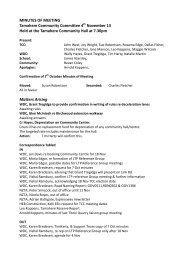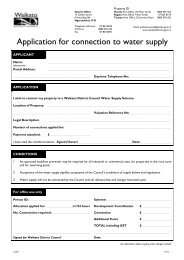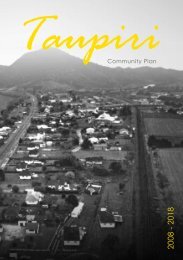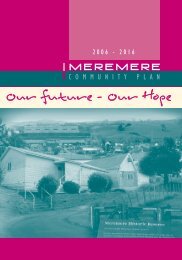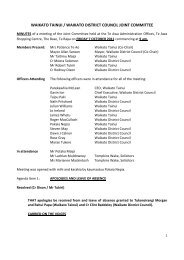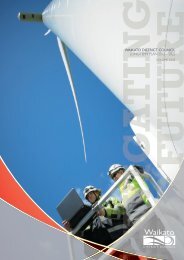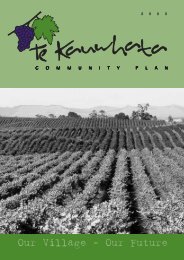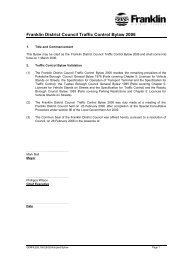1.2 Purpose of this waste assessment - Waikato District Council
1.2 Purpose of this waste assessment - Waikato District Council
1.2 Purpose of this waste assessment - Waikato District Council
- No tags were found...
You also want an ePaper? Increase the reach of your titles
YUMPU automatically turns print PDFs into web optimized ePapers that Google loves.
goal <strong>of</strong> the Fund, and ensure that their application demonstrates a contribution to these goals.The latest information available on the fund suggests that the main <strong>assessment</strong> point is likely to be whatthe Ministry describe as ‘largest net benefit over time’ eg amount <strong>of</strong> <strong>waste</strong> diverted from landfill per dollar<strong>of</strong> funding), alongside supporting criteria such as likelihood <strong>of</strong> success, reducing environmental harm, widersustainability benefits, and longevity. Projects that can act as trailblazers for the rest <strong>of</strong> New Zealand will also befavoured. The Ministry strongly encourages partnership working and collaboration.While no minimum ‘match’ funding has been specified, the Ministry has made it clear that projects with higherlevels <strong>of</strong> match funding will be seen as demonstrating successful collaboration and a greater likelihood <strong>of</strong> successand longevity.The first funding round opened on 1 December 2009, and applications closed at 5pm on 1 March 2010.Successful projects commenced in August 2010. The next funding round ran during in January – March2011, with projects starting in August/September 2011. A third round is expected in late 2011 and MfE hasannounced that <strong>this</strong> will be a ‘targeted’ round.A.2.4.5Emissions Trading Scheme (ETS)In its current form, The Climate Change (Emissions Trading) Amendment Act 2008 will require landfill ownersto surrender emission units to cover methane emissions generated from the landfill, thereby impacting on thecost <strong>of</strong> landfilling. Should any future solid <strong>waste</strong> incineration plants be constructed, the Act would also requireemission units to be surrendered to cover carbon dioxide, methane and nitrous oxide emissions from theincineration <strong>of</strong> household <strong>waste</strong>s. The <strong>waste</strong> sector will not formally enter the ETS until 1 January 2011, atwhich time voluntary reporting can occur. Mandatory reporting requirements will apply from January 2012 andemission units will need to be surrendered as <strong>of</strong> 2013.Emissions for <strong>waste</strong> will be accounted for within the year that the <strong>waste</strong> is disposed <strong>of</strong> to landfill – ie the totalamount <strong>of</strong> methane that <strong>waste</strong> is expected to produce will be calculated, reported, and require NZUs in theyear it goes to landfill. This does mean that closed landfills will not require any reporting or NZUs. ‘Legacy’closed landfills have been excluded from the ETS.The definition <strong>of</strong> a disposal facility will be the same as applies in the Waste Minimisation Act (2008).This DEF assumes that no landfill gases are collected or destroyed in any way, and incorporates an assumptionthat 10 per cent <strong>of</strong> methane in a capped landfill is oxidised to CO2 before being emitted to the atmosphere.For a DFO to use a UEF, they must carry out a prescribed Solid Waste Analysis Protocol (SWAP) surveyprocess for a year’s <strong>waste</strong>. This SWAP survey must categorise the <strong>waste</strong> by source, as municipal solid <strong>waste</strong>,commercial and industrial, building and demolition, and other. Within each source, the fraction <strong>of</strong> the following<strong>waste</strong> materials must be calculated: food <strong>waste</strong>, garden <strong>waste</strong>, paper, wood, textiles, nappies, sewage sludge,and other.For each <strong>of</strong> these <strong>waste</strong> materials, a standard proportion <strong>of</strong> degradable organic carbon (DOC) has beencalculated. These are shown in Table 23. ‘Other materials’ are assumed to have zero DOC.Table 23: Proportions <strong>of</strong> degradable organic carbon, by materialWaste materialDOCFood <strong>waste</strong> 0.15Green <strong>waste</strong> 0.20Paper 0.40Wood 0.43Textiles 0.24Nappies 0.24Sewage sludge 0.05The regulations require landfill operators to undertake two <strong>waste</strong> surveys over a 12 month period with the58



